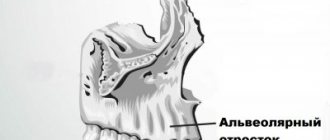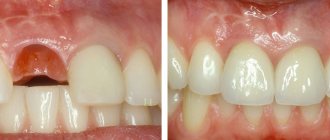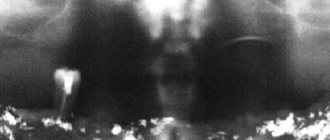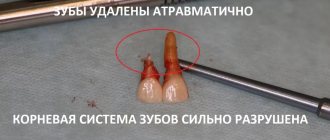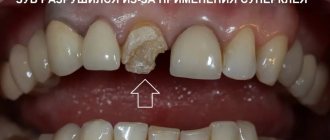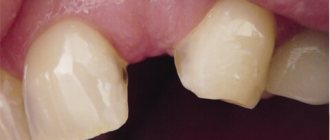According to antiplagiat.ru, the uniqueness of the text as of October 16, 2018 is 99.4%.
Key words, tags: implantation, installation of Astra Tech Implant System implants, sinus lift, radiography.
Dental implantation sometimes requires restoration of the lost volume of the jaw bone. And although at first glance this sounds scary, bone augmentation in the oral cavity is today a widespread type of surgical intervention throughout the world and in Russia, in particular.
Historical reference
“Augmentation (Latin augmentatio, from augmentare to increase, strengthen) is the process of restoring or replacing jaw bone tissue. This is not as new a direction in dentistry as it might seem. Bone augmentation began to develop tirelessly in the 19th century, so scientifically based plastic bone transplants were carried out by Walther (Ph. Walther, 1821) and Wolff (1. Wolff, 1863). In our country, the founder of osteoplastic surgery is N.I. Pirogov, who in 1852 performed an operation and initiated bone transplantation on a pedicle. And the first attempts to carry out bone tissue transplantation in the maxillofacial structure were carried out in 1891 by doctors P.I. Dyakonov. and Deshin A.A.”*
Material and methods
In 2010 - 2011 in the Department of Plastic and Maxillofacial Surgery of the Russian Scientific Center for Surgery named after. acad. B.V. Petrovsky performed 15 operations on the upper jaw using the iliac crest and 20 operations on the lower jaw with parietal autografts; in all clinical situations, the possibility of placing dental implants was achieved.
To eliminate the vertical deficiency of bone tissue in the area of implant placement in the projection of the mandibular neurovascular bundle, we used the transplantation of parietal autografts from the lingual and vestibular sides. Bone chips were compacted between the bone blocks (see Fig. 8,9). After 6 months, we removed the skeletal screws and installed dental implants.
To reconstruct the alveolar process in the projection of the maxillary sinus with extended defects and severe atrophy of 0.5 mm, the iliac crest was used with osteotomy of the anterior wall of the maxillary sinus and fixation of the graft to the palatine bone. After 6 months, the implants were installed (see Fig. 14, 15, 16).
Patient A. , 59 years old, came to the clinic for the manufacture of fixed dentures on the lower jaw. The patient had bone tissue atrophy, 2-3 mm down to the mandibular canal.
Orthopantomogram of patient A. before surgery
Treatment choice tactics: three-dimensional reconstruction of the alveolar process in the lateral areas using mandibular cortical autoblocks is impossible due to the insufficient volume of donor bone tissue.
In this case, we chose the parietal bone, since the resorption of bone grafts of intramembranous origin occurs more slowly than that of enchondral ones [5].
For access and collection of parietal autografts, a semi-coronal incision was used. We collected 4 parietal autografts measuring 4*2.5 cm and 3*2 cm in quantities of 3 and 1, respectively.
Access for harvesting and harvested parietal bone autografts
The collected bone blocks were fixed. After fixation of the bone blocks, the space between the autografts (vestibular and lingual) is augmented with autografts mixed with venous blood.
Fixation of autologous bone grafts from the vestibular and lingual sides, augmentation with autoshafts, scheme for fixation of grafts from the vestibular and lingual sidesA similar operation was performed on the left. The wounds are sutured with U-shaped and interrupted sutures, without tension, creating mucoperiosteal “bags”.
Orthopantomogram of patient A. after surgery
After 6 months, dental implantation was performed. During implantation, there was a good blood supply to the bone tissue, which was similar in properties to the mandibular tissue. The negative side of this method is the need to perform vestibuloplasty at the stage of installing gum formers.
Dental implantation patient A. after 6 months
Orthopantomogram of patient A. after dental implantation
Patient B. , 32 years old, came to the clinic to install dental implants in the area of teeth 25,26,27. An orthopantomogram and CT scans showed a height of the maxillary sinus floor of less than 0.5 mm, which is called the “eggshell” symptom.
Orthopontomogram of patient B. patient before surgery
A trapezoidal incision was made from 23 to 27, and the mucoperiosteal flap was detached. A through defect in the anterior wall of the maxillary sinus was noted, which makes successful sinus lift difficult. An osteotomy of the anterior wall and floor of the maxillary sinus was performed. An autograft was collected from the iliac crest according to the defect of the alveolar process of the upper jaw. Modeling was performed and the graft was fixed to the palatal wall of the maxilla with long screws, the anterior wall of the maxillary sinus was returned to its place and fixed. The wounds are sutured with periodontal and interrupted sutures.
Stages: incision and tissue detachment, harvesting, fixation of the iliac crestThus, since the ilium is enchondral, covering the vestibular and palatal sides with cortical plates, we give it the properties of membranous bone.
Postoperative orthopantomogram and fixed bone graft
After 4 months, dental implantation was performed. When forming a bed for implants, good blood supply to the graft and an increase in bone tissue density were noted.
Orthopantomogram of patient B. after surgery
Patient V. , 70 years old, went to a private dental clinic. The patient was noted to have unilateral vertical atrophy of the alveolar process of the mandible. Vertical reconstruction was performed using mandibular blocks under local anesthesia.
Orthopantomogram of patient V. before surgery
Mandibular bone blocks and fixed grafts from the vestibular and lingual sides
Split free bone grafts from the branches of the lower jaw were fixed on the vestibular and lingual sides, the space between the grafts was augmented with xenogeneic material "BiOss". The wounds are sutured with U-shaped and interrupted sutures to form mucous-muscular “bags”.
Orthopantomogram of patient V. after surgery
Anatomy of human jaw bone tissue
Bone tissue is a special, hard form of connective tissue. Bone tissue cells are represented by osteoblasts, osteoclasts, and osteocytes, which participate in the continuous process of tissue resorption (resorption) and repair (restoration). In both cases, these are normal physiological processes of bone tissue. It is also worth noting that bone resorption (resorption) can simultaneously be a pathological process, provoked by injuries, infections, various types of formations and due to tooth loss. For example, after 2-3 months after tooth extraction, characteristic signs of bone tissue atrophy are observed, since there is no fixation of the roots of the teeth and the bone does not receive the necessary load. This process is characterized by a noticeable decrease in its volume.
The bone tissue of the jaw consists of a spongy and compact layer , which in turn is covered by the periosteum , with the exception of the articular surfaces. Periosteum is a connective tissue rich in blood vessels, has a complex structure and is responsible for nutrition and bone regeneration. Compact bone is a dense and homogeneous bone tissue that makes up the surface layers of bones filled with spongy substance. The spongy layer (substance) has a developed blood vascular network, consisting of trabeculae or bone plates located in different directions and forming a system of cavities in the bone tissue, which makes it look like a sponge. In dentistry, it is the spongy part of the bone tissue that is most used for fixing implants. If the volume is insufficient, this layer has to be restored using augmentation.
The reality of our days
Human body augmentations in the form of high-tech limbs are already being tested on small groups of people. And while innovative bionic limbs and exoskeletons can change a lot, we are still far from a situation in which a person could voluntarily get rid of a good arm in order to replace it with a “better” cybernetic version.
Image courtesy: Eidos Montreal - Deus Ex: Mankind Divided
It's worth noting that Will Rossellini, the CEO of a neurotech company that also served as a consultant on the latest video game Deus Ex, predicts that "our bodies in the future will be like cars in the sense that we will be able to make parts that fit anyone's system." person. Just as easily as we, for example, now update mobile phones.”
However, what do we see now? A much more viable alternative is robotic exoskeletons, which do not require replacing human body parts to reap benefits such as additional strength, agility or endurance. For several years now, exoskeletons have been used to enable paralyzed people to walk in the park, run, or even climb mountains! In addition, exoskeletons can be used on an industrial scale and, of course, for military purposes.
The Army already appreciates their capabilities, developing many projects that will help soldiers travel further and more easily carry heavier loads and weapons. At the same time, providing greater protection against bullets and explosions than current body armor and helmets. According to the concept, the final implementation of such military equipment will likely be a super-armored suit similar to the one worn by Iron Man.
If we talk about internal changes in the human body, then this topic is also quite rich. In the future, they are likely to develop to such an extent that they significantly improve standard human performance and at some point become a completely acceptable option for healthy people.
Much of the current developments in brain enhancement are still research-based, but work in brain mapping and computer interfaces is in full swing.
Most scientists agree that over the next few years we will see an increase in the number of brain implants that provide monitoring and even communication functions - the benefits they provide certainly outweigh the possible risks.
Types of Augmentation
The formation of extensive bone tissue defects is usually caused by infectious processes at the apexes of the roots of the teeth; subsequent removal of such teeth often increases the size of these defects. In the frontal region of the upper jaw, bone loss also often occurs due to dental trauma. All this results in the fact that the volume of bone tissue is not enough to install implants: the alveolar ridge can be very narrow, or its height can be significantly reduced. Depending on this, alveolar process augmentation surgery is divided into horizontal and vertical, according to the direction in which the bone tissue is built up.
Horizontal augmentation is an increase in the width of the alveolar ridge; it is most often performed in the anterior part of the upper jaw and posterior parts of the lower jaw. This is a relatively standard and predictable procedure. The preserved height of the alveolar ridge allows you to use the existing bone volume and gain its width.
With vertical augmentation, the height of the alveolar ridge increases. If there is insufficient volume of bone tissue in height, it is more difficult to isolate and immovably fix the augmented augmentation. Therefore, in dental practice, this operation is considered more responsible, time-consuming and less predictable than horizontal augmentation.
Alveolar ridge augmentation is a preparation for implantation and is usually done several months before. In some cases, bone augmentation is carried out simultaneously with the installation of implants.
Become a machine
Image courtesy of Eidos Montreal - Deus Ex: Human Revolution
It is known that normally the human body rejects implants due to the lack of histocompatibility with the body, which leads to numerous protective reactions of the immune system, including attempts to destroy them. As a result, a person either dies due to severe inflammation in the body, or lives forced to regularly take immunosuppressants.
Research is already underway to develop measures that would allow the human body to stop rejection, which is a real obstacle to the practical implementation of human augmentation.
Thus, Russian and Swiss scientists are working on creating measures that could stop rejection. Physicists at Moscow State University even created a magnetic field that helps avoid implant rejection.
In one of the latest cult game series about the future, Deus Ex, the main character Adam Jensen literally burns to death at work. One day he receives fatal gunshot wounds while trying to stop a terrorist attack. The corporation he works for replaces Jensen's body parts with mechanical ones in order to keep the main character alive - and make him even better than before.
The hero lives in a futuristic world in 2030, where body augmentations are widespread to improve everything: memory, social interaction, vision and physical capabilities. However, the fight against the old world is just beginning.
Types of osteoplastic materials
Currently, a wide selection of both biological and synthetic osteoplastic (osteoplastic) materials are available to restore lost bone volume.
The most important characteristic of augmentation materials is their ability to osteogenesis (bone formation). They are classified according to the severity of this ability. Thus, a distinction is made between osteoinductive materials, which directly affect bone growth, and osteoconductive materials, which are used only as a framework for new bone tissue formation.
In addition, bone material is distinguished by its origin. Thus, the patient’s own osteoplastic material can be used for transplantation. It has always been considered the “gold standard”, since in this case there is complete biocompatibility and they are called autogenous materials. Also, when performing alveolar process augmentation, material from another person is used - allogeneic, of animal origin - xenogeneic, or artificially made materials - alloplastic. The choice of this or that material is determined solely by the dental surgeon, depending on the clinical situation and the desired result.
Progress drives the opposition
An alternative would be the possibility of affordable body enhancement through some kind of socially funded programs. The problem is that this idea is likely to be met with stiff resistance among the world's more traditional cultures and reactionary groups.
However, if improvements are made available only to rich people and become a way to transcend nature and go beyond human capabilities, a reaction is inevitable.
It is likely that many religious groups will view the impact of advanced technology on the human body as playing God, because the connection of man and machine was not originally intended by providence. Religions are likely to seriously impede human technological improvement, and there is no doubt that in certain regions of the world the opinions of religious leaders will carry significant weight.
However, in many other areas of the world, religious opposition is unlikely to constitute a majority, and if human augmentations do provide benefits, then they have a fairly good chance of being fully accepted by society.
Indications
Augmentation may be required if the patient, for one reason or another, does not have enough volume of his own bone tissue for reliable fixation of the implant, as well as functional and aesthetic rehabilitation. These reasons may be long-term tooth loss, trauma during tooth extraction, infections, household or sports trauma to the jaw, and other diseases. In addition, bone augmentation is used for periodontitis, when there is a high risk of complete tooth loss, to fill the cavity after removal of a dental cyst and to reduce the depth of the maxillary sinuses, the so-called sinus lift. But in any case, this type of surgical intervention is performed solely for medical reasons.
Medical disadvantages of improvements
However, one of the noted disadvantages of such enhancements in the fictional world of Deus Ex was the need for anti-rejection drugs - the so-called drug Neuropozyne was expensive and strictly controlled. Those who lacked money simply had to face the painful prospect of their bodies rejecting their technological improvements.
And, according to the latest news from our world, real developments are not so far different from what was said above. Thus, a few years ago, three Austrians removed their arms and, during a surgical operation, replaced them with prosthetics controlled by mental impulses. Of course, they definitely had reasons for this - all three suffered from severe damage to the nervous system.
IImage courtesy: Eidos Montreal — Deus Ex: Mankind Divided
However, an element of the story whose impact should not be underestimated was the drug addiction that all three developed. The Guardian reports that surgeon Dr Oskar Asmann from the Medical University of Vienna confirmed that all three men will now have to take anti-rejection drugs for the rest of their lives.
In many countries with a public health care system, such treatment (after assessing its costs) would be unlikely.
However, other countries like the United States have a private healthcare system, and for them a scenario similar to the Neuropozyne scenario is quite real. The only question is, when will we reach the stage of development where everyone can voluntarily improve their body and mind? One thing is certain: if (or rather, when) this happens, all the hypothetical risks will become reality.
Contraindications
All the main contraindications typical for any type of surgery, including implantation, also apply to augmentation. This operation is contraindicated for people suffering from chronic diseases in the decompensation stage and some mental illnesses in the acute stage. Patients undergoing courses of radiation/chemical therapy, with infectious diseases in the acute stage, as well as during periods of recovery and rehabilitation, during pregnancy and breastfeeding, are also not recommended to undergo surgery to increase the volume of the jaw bone.
Race in the labor market: improve yourself or starve
What problems may arise for humanity? One of the possible challenges of the near future is the likelihood of an increasing number of "enhanced" people who will gain advantages by competing for jobs with people who do not accept improvement.
It's easy to see the big picture: we'll end up with a future job market where career opportunities will be significantly reduced for ordinary people. You simply cannot get a decent job without improving yourself technically.
All this will quite quickly lead to a split within society and to the dominance of rich groups of people on such a scale as it was, say, in the Middle Ages. And the spread of mass enhancement of the human body will only worsen this situation.
Age restrictions
There are no obvious age restrictions for alveolar bone augmentation. Thus, this surgical intervention can be performed on children and adolescents to treat bone tissue defects resulting from accidents or diseases, as a result of defective or delayed development of the jaw bones. As for the older generation (adults over 55-60 years of age or more), the main thing is that health indicators are within acceptable limits, which must be taken into account when carrying out this type of operation.
A question of aesthetics
Recent news shows that worldwide acceptance of people whose appearance would be changed through augmentation could easily be achieved.
Thus, at the end of September 2022, Chiara Bordi, one of whose legs is a bionic prosthesis, became a finalist in the Miss Italy 2018 competition. The girl took third place.
Chiara's natural charm has undoubtedly allowed her to steal many men's hearts around the world. However, numerous critics say that Bordi was able to get a place in the final only thanks to political correctness: it was supposedly that her missing leg was her ticket to the competition. However, after looking at Miss Bordi, you will understand that she really deserves to receive the title of Miss Italy.
Chiara Bordi is 18 years old and lives in the small town of Tarquinia in Central Italy. Chiara lost her leg in an accident when she was 13 years old - a girl riding a bicycle was hit by a car. Since then, Chiara has learned to live with a bionic prosthesis, managed to get into the modeling business and, apparently, overcome her inhibitions. In response to critics who claim that she was chosen to be Miss Italy only because she doesn’t have a leg, Bordi says: “But you don’t have a brain.”
Price
The cost of augmentation consists not only of the cost of the operation itself, but also of other factors, including the size and shape of the operated area. It is also important what material will be used for replanting, its volume and manufacturer. It is also necessary to know that augmentation is a complex operation and its successful outcome will require a highly qualified maxillofacial surgeon and an experienced operating team. After all, augmentation can be called a qualitative test of a doctor’s professionalism, since it requires pinpoint precision and places great responsibility on the doctor’s shoulders. Accordingly, the better the specialists performing the operation, the higher the cost of providing the service. Additional costs to consider are x-rays and CT scans. In individual cases, consultation with specialists may also be required for a more complete clinical picture.
It is important to remember that augmentation is one of the main manipulations before implantation and cannot be neglected. After all, the reliability of implant fixation depends on the density of bone tissue, which means the beauty and durability of your smile!
According to antiplagiat.ru, the uniqueness of the text as of October 16, 2018 is 99.4%.
Key words, tags: implantation, installation of Astra Tech Implant System implants, sinus lift, radiography.
* History of the Department of Human Anatomy, Faculty of Medicine, Russian National Research Medical University named after. N.I. Pirogov. **Images: Maxillary atrophy: classification and surgical protocols. Astra Tech DENTSPLY Implants. BioHorizons.
results
From 2010 to 2011 in the Department of Plastic and Maxillofacial Surgery of the Russian Scientific Center for Surgery named after. acad. B.V. Petrovsky performed 15 operations on the upper jaw using the iliac crest and 20 operations on the lower jaw using parietal autografts. In all clinical situations, the possibility of placing dental implants was achieved.
The developed method of three-dimensional vertical reconstruction of the lower jaw using parietal grafts makes it possible to increase the height of the jaw in the lateral sections to 10-15 mm, the width to 10-13 mm, according to our practice. The peculiarity and novelty of this operation is the fixation of the bone graft on the lingual side.
The developed method of three-dimensional reconstruction in the projection of the maxillary sinus makes it possible to increase the vertical volume to 10-15 mm and the width to 8-10 mm.
Methods
Augmentation, depending on the characteristics of the patient’s oral cavity, purpose, and level of bone tissue, can be carried out using two methods:
- Closed. The indication is the presence of bone tissue, the height of which is 7-8 mm.
In this case, the specialist does not make an incision in the gum, but introduces bone tissue using a puncture. The incision is made only for implantation. The advantage is a shorter rehabilitation period, since the doctor does not apply stitches after the extension. Installation of the structure is possible immediately after the insertion of bone tissue. - Open. It is carried out when there is a significant lack of hard tissue, when its height is less than 7 mm.
The procedure is longer than the closed method because an incision is made in the gum. The engraftment period of the implanted tissue is more than 20 weeks, after which the implants are installed.
The choice of method for the bone tissue implantation procedure is made by the attending physician after studying the diagnostic results.
Progress of the procedure
Before the operation, a painkiller is administered. In some cases, the procedure can be performed under general anesthesia. The public method is performed in several stages:
- Incision. The doctor makes a soft tissue incision and removes part of the mucous flap.
- Providing access. A small hole is drilled above the implant site using a special device.
- Raising the bottom.
- Filling the cavity with osteoplastic material. The specialist inserts bone tissue.
- Return of the mucous flap , suturing.
The main advantage of the method is its versatility, as it can be performed on any volume of bone tissue. But the disadvantages include a long healing process and a large amount of work for a specialist.
The closed method takes less time and the recovery process is much shorter. The procedure will also be performed in several stages:
- Drilling bone. No soft tissue incision is made. The resulting hole is used first to implant bone tissue and then to install an implant.
- Sinus elevation. A special probe is used for this.
- Filling the cavity.
- Implant installation.
After suturing, the surface is treated with an antiseptic solution to prevent the development of inflammation and the penetration of pathogenic microorganisms.
The closed method of augmentation is much easier for patients to tolerate. In addition, during one visit it is possible to carry out not only a procedure to increase the volume of hard tissue, but also installation of a structure.
From the video you will learn the purpose and how of augmentation.
Cybernetic hands
For a long time, prosthetic limbs were a primitive dummy, which was almost impossible to move. The Scottish company Touch Bionics managed to carry out a micro-revolution in hand prosthetics. Her i-Limb cyber prosthesis gives a person the ability to use their hand, such as carrying weights and grasping small objects with their fingers.
No surgery is required to install the i-Limb: the cyberprosthesis is controlled using sensors connected to the muscles of the forearm. Accordingly, in order to move a cyber hand, it is enough to tense the muscles as if it were a real hand.
Owners of i-Limb claim that at times it feels like the cyber prosthesis is their real hand. Of course, this feeling is deceptive and is actually formed by the brain based on past memories.
Touch Bionics i-Limb
Touch Bionics i-Limb
The i-Limb cyber prosthesis is one of the most affordable, but far from the most high-tech. The American defense agency DARPA finances two biomechatronics projects at once, which have managed to advance almost a decade ahead compared to i-Limb.
DARPA places great hopes on its own cyber arm, which is controlled not by the muscles of the forearm, but by the brain. To do this, a microchip is implanted into the brain, which records neuronal signals and transmits them to the prosthesis. The main advantage of the DARPA project is the high precision of movements, which allows you to manipulate anything, even musical instruments.
DARPA also funds an alternative project to create a cyber arm, the Deka Luke Arm, authored by American inventor Dean Kamen. On its side is a modular design, which makes it easy to adjust the cyber prosthesis to the needs of a specific user. Luke Arm can be controlled by whatever part of the body the owner wishes, such as the foot. That is, to move the cyber arm, you just need to tap your foot.
Deka Luke Arm
Deka Luke Arm
As they say, more to come: the Swedish-Italian Smart Hand project is actively working on the “reverse impact” of the cyber hand. The prosthesis will be able not only to receive signals from the brain, but also to transmit tactile sensations to it.
Smart Hand
Smart Hand
In cases where the hand is not lost, but due to problems with the nervous system it has lost the ability to move, Possessed Hand will come to the rescue. The device is worn on the arm and stimulates the muscles according to a given program, and therefore can also help healthy people. For example, those who want to learn how to play the violin, sculpt with clay or juggle balls.
Possessed Hand
Possessed Hand
And this is, in fact, human augmentation, in which, most importantly, you do not have to sacrifice a healthy limb for a cybernetic one, even a more thorough one. True, the Possessed Hand project is still quite far from the final stage of development.
Cybernetic legs
From an engineering point of view, it is easier to create cyber prosthetic legs, because in this case it is not necessary to imitate the exact movements of the fingers. But there is another difficulty: effective shock absorption is required, otherwise a person will sway a lot when walking quickly.
The most complex cybernetic leg in its design was created at the American Vanderbilt University. It consists of a large number of sensors and motors. The former determine the position of the leg in space, and the latter, in response, move the artificial joints.
This cyber prosthesis allows you to sit down and stand up with ease, as well as walk up the stairs, which most analogues are not capable of. The device weighs only 4 kg, and on one battery charge it can work for three days in gentle mode or one intense walk of one and a half dozen kilometers.
Vanderbilt University Cyberleg
Vanderbilt University Cyberleg
An alternative development, the Power Foot cyber prosthesis, is capable of simulating the pressure of a human leg. Its creator is Hugh Herr, a professor at the Massachusetts Institute of Technology. He lost both legs, which is why he tests the Power Foot personally.
Hugh Herr is one of the bright minds of modern biomechatronics
Hugh Herr is one of the bright minds of modern biomechatronics
Another direction in the development of leg cyberprostheses is interchangeable attachments for athletes. Thus, the South African runner Oscar Pistorius with springy Flex-Foot prostheses participates in competitions along with healthy athletes and even managed to compete at the 2012 Olympics in London. This once again proves the capabilities of modern biomechatronics and the strength of the human spirit.
Athlete Oscar Pistorius, nicknamed Blade Runner
Athlete Oscar Pistorius, nicknamed Blade Runner
